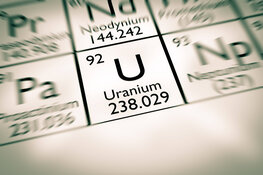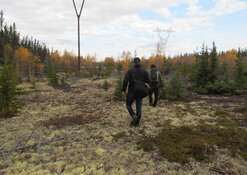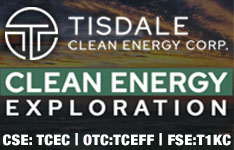The growth of artificial intelligence, the need for more computer data centers, the eventual adoption of electric vehicles (EVs), and the need for more net-zero power means a renaissance in nuclear power is underway.
Just last month, Microsoft Corp. (MSFT:NASDAQ) announced a deal with Constellation Energy Group (CEG:NYSE) to restart and buy all of the power from one of the shut-down reactors at its infamous Three Mile Island plant in Pennsylvania and the Biden administration also announced a plan to restart the Palisades plant in Michigan.
"Biden has called for a tripling of U.S. nuclear power capacity to fuel energy demand that is accelerating in part due to expansion of power-hungry technologies like artificial intelligence and cloud computing," Valerie Volcovici wrote for Reuters on Oct. 8.
The administration also wants to develop small nuclear reactors (SMRs) for certain applications.
All of this is putting the metal needed to power nuclear energy, uranium, front and center. Prices for the element have started rising, with nuclear fuel trading at US$83.30 per pound last Thursday, a level not seen since 2007, according to a report by Daily Finland on Friday.
Uranium prices are expected to move higher by the end of this quarter, when Trading Economics' global macro models and analyses forecast uranium to trade at US$84.15 per pound, Nuclear Newswire reported on Oct. 3. In another year, the site estimates that the metal will trade at US$91.80 per pound.
The Catalyst: Surging Demand
The engine driving the prices is a "fundamental global shortage" of uranium driven by surging demand, said Andre Leibenberg, chief executive officer of Yellow Cake, which is focused on providing exposure to uranium's spot price.
The demand is stemming not only from a growing recognition of nuclear power's role in the future energy mix, but also from its critical importance in supporting the AI boom and the development of data centers, he wrote in a company update last week, according to Mining Weekly.
According to the report, Liebenberg noted that the primary mine supply of 140 million pounds was significantly trailing behind global demand of more than 180 million pounds a year.
In the European Union, a "lack of clarity" about Russian uranium imports is holding back investment in new enrichment plants, according to Reuters.
Russia supplied more than 25% of European and American enriched uranium before the start of the Ukraine war in February 2022, the report said.
Since then, "the U.S. implemented a ban on imports of enriched uranium from Russia in August, with some exemptions, but in Europe, different countries have taken different approaches," muddying the waters.
Complicating matters is a hint in September that Russian President Vladimir Putin might embargo exports of the vital element to the west.
Citi, in a note to clients, said utilities have been stockpiling Russian uranium, but an embargo would make it "hard to replace" supplies of the metal in the next two years.
"Russia supplies close to 12% of U3O8 (known as yellow cake), 25% of UF6 (uranium hexafluoride) and 35% of EUP (enriched uranium product) to international markets," the bank said, according to Forbes. "While the largest share of these supplies goes to China and in supplying nuclear reactors that were built by Russia's Rosatom, we believe that at-risk supplies are exports to the U.S. or Western Europe."
The consequences of what could happen without more nuclear power can be seen in the U.K., where the number of reactors is shrinking. Four of five of them are expected to close in the next couple of years, which could "stretch the grid to the limit."
"As Britain's reactor fleet shrivels, the amount of nuclear capacity will fall from six gigawatts (GW) today to just 1.2 GW by 2028 or soon after," Jonathan Leake and Matt Oliver wrote for The Telegraph last week. "Along with rising demand from power-hungry data centers and technologies of the future, it will make it even harder to keep the lights on when wind and solar generation is low."
Small Nuclear Reactors (SMRs)
SMRs are another possible solution for some medium-sized energy needs. They have been operational for dozens of years in submarines and other long-distance ocean-going craft.
"They can be manufactured in factories and then rapidly erected on-site," Dominic Frisby wrote for his newsletter, The Flying Frisby, on Oct. 13. They are scalable, and that flexibility "aids manufacture, transportation, and installation while reducing construction time and costs."
A 440-megawatt (MW) SMR would produce about 3.5 terawatt hours (TWh) of electricity per year, enough for 1.2 million homes, Frisby noted.
SMRs produce electricity that can easily be adjusted to meet the constant, everyday needs of the grid (baseload), and they can also ramp up or down to follow changes in demand throughout the day, the author wrote. They spin in sync with the grid, so they help keep everything stable.
"When they're running, they act like a steady hand, providing momentum that makes it easier to manage sudden changes in electricity supply or demand," he wrote.
'Bucket Loads of Power' Needed
All of this equates for a bright future for the metal, he said.
"Guess what? AI requires bucket loads of power," Frisby wrote. "That's why Microsoft recently agreed to pay Constellation Energy, the new owner of America's infamous nuclear power station, Three Mile Island, a sizeable premium for its energy. There is cheaper wind and solar power to be had in Pennsylvania, but it isn't as reliable as nuclear 24 hours a day. It's not just AI. The widespread political desire to rid ourselves of fossil fuels means the world needs electricity, and fast."
Chris Temple, publisher of The National Investor, recently noted that with the Three Mile Island deal, "uranium/nuclear power is BACK!"
"I've watched as the news has continued to point to uranium being in the early innings of this new bull market," Temple wrote. "Yet the markets have been yawning . . . until now."
What follows are several uranium explorers and producers that could benefit from this upswing for investors looking to take advantage.
Baselode Energy Corp.
Baselode Energy Corp. (FIND:TSX.V; BSENF:OTCQB) controls 100% of about 273,000 hectares for exploration in the Athabasca Basin area in northern Saskatchewan, Canada.
 Streetwise Ownership Overview*
Streetwise Ownership Overview*
Baselode Energy Corp. (FIND:TSX.V; BSENF:OTCQB)
The company said it discovered the ACKIO near-surface, high-grade uranium deposit in September 2021. ACKIO measures greater than 375 meters along strike, greater than 150 meters wide, and is comprised of at least 11 separate zones. Mineralization starts as shallow as 28 meters beneath the surface and continues down to about 300 meters depth beneath the surface, with the bulk of mineralization occurring in the upper 120 meters, Baselode said. ACKIO remains open to the west and south and along the Athabasca sandstone unconformity to the east and south.
Earlier this month, the company reported positive uranium assay results from three drill holes of its 2024 drill program at ACKIO.
Notably, drill hole AK24-119 intersected 0.28% U3O8 over 21.0 meters, including a high-grade section of 1.55% U3O8 over 1.5 meters at a depth of 141 meters. While drill hole AK24-118 returned 0.59% U3O8 over 8.5 meters, including 1.25% U3O8 over 1.5 meters at a depth of 153 meters.
"These results strengthen our confidence in ACKIO," Chief Executive Officer James Sykes said in a release. "It's remarkable that, just over three years after discovering ACKIO, we're still achieving better-than-expected grades and widths."
Baselode expects further assay results from the remaining 40 drill holes to be released after quality review and approval.
David Talbot, Managing Director at Red Cloud Securities, noted in a September 17 report that drilling at ACKIO "continued to expand the mineralized footprint at Pods 1, 6, and 7," highlighting that "thirteen holes reported composite intervals of anomalous radioactivity between 11m and 42m in thickness."
In his report, Talbot rated the stock as a Buy and further projected the potential for "8-10-12 million pounds of U3O8 at a grade of ~0.3% U3O8," which aligns with typical grades found in the southeastern part of the Athabasca Basin.
According to Refinitiv, Baselode has institutions holding 23.26% with Alps Advisors holding the bulk of it with 17.94%, followed by Vident Investment Advisory LLC at 2.97%. Management and Insiders hold 1.59%. The rest is retail.
The company has a market cap of CA$20.05 million, with 131.51 free float shares. It trades in the 52-week range between CA$0.10 and CA$0.61.
Uranium Energy Corp.
According to its website, Uranium Energy Corp. (UEC:NYSE AMERICAN) is America's "largest and fastest growing supplier of uranium."
 Streetwise Ownership Overview*
Streetwise Ownership Overview*
Uranium Energy Corp. (UEC:NYSE AMERICAN)
The company said it is advancing the next generation of low-cost, environmentally friendly in-situ recovery (ISR) mining uranium projects in the United States and high-grade conventional projects in Canada. It has two production-ready ISR hub and spoke platforms in South Texas and Wyoming.
Additionally, Uranium Energy Corp. said it has diversified uranium holdings with one of the largest physical uranium portfolios of U.S. warehoused U3O8; a major equity stake in Uranium Royalty Corp., the only royalty company in the sector; and a Western Hemisphere pipeline of resource stage uranium projects.
Most recently, the company announced it was expanding its U.S. uranium production capacity by acquiring Rio Tinto Plc.'s Sweetwater Plant and a portfolio of Wyoming uranium assets.
On September 25, Temple of The National Investor noted that UEC was "upgraded back to Buy" following recent uranium market news. He pointed to UEC's acquisition of the Wyoming uranium assets as a catalyst, emphasizing that uranium is "in the early innings of this new bull market."
Jeff Clark of The Gold Advisor, in his September 26 update, called the acquisition a "significant move," noting that it consolidated a large portfolio of uranium assets under UEC's control, positioning the company for rapid growth. He also highlighted the company's strategic advantage with "53,000 additional acres for exploration," reinforcing UEC's potential to ramp up production.
According to Reuters, Uranium Energy has a market cap of US$3.48 billion and 411.41 million shares outstanding. It trades in a 52-week range of US$4.06 and US$8.66.
About 2% of UE is help by management and insiders, Reuters noted. The largest portion, 77.58%, is held by institutional investors. The rest is in retail.
Terra Clean Energy Corp.
Formerly Tisdale Clean Energy Corp., Terra Clean Energy Corp. (TCEC:CSE; TCEFF:OTC; T1KC:FSE), a Canadian-based uranium exploration and development company, is currently developing the South Falcon East uranium project, which holds a 6.96-million-pound inferred uranium resource within the Fraser Lakes Zone B uranium/thorium deposit, located in the Athabasca Basin region of Saskatchewan.
 Streetwise Ownership Overview*
Streetwise Ownership Overview*
Terra Clean Energy Corp. (TCEC:CSE; TCEFF:OTC; T1KC:FSE)
Representing a portion of Skyharbour Resources Ltd.'s existing South Falcon Project, Terra Clean Energy's project covers approximately 12,464 hectares and lies 18 kilometers outside the Athabasca Basin, approximately 50 kilometers east of the Key Lake Mine.
Recently, the company announced a comprehensive exploration program set for Winter 2025 at its South Falcon East Uranium Project. The work will focus on extending the mineralized footprint at the Fraser Lakes B Uranium Deposit and includes about 2,000 meters of infill and step-out drilling designed to verify existing mineralized zones and identify additional targets.
In a release, Chief Executive Officer Alex Klenman described the initiative as "a unique setup for a Canadian microcap, offering multiple paths to significant value creation." This US$1.5 million project will involve TerraLogic Exploration Inc., operating out of SkyHarbour's McGowan Lake Camp with helicopter support.
According to Reuters, management and insiders hold 4.62% of Terra Clean Energy. Of those, Alex Klenman holds the most, with 4.37%.
Strategic Investors hold 12.03%, with Planet Ventures Inc holding the most at 7.40%. The rest is retail.
Terra Clean Energy has a market cap of CA$2.98 million and a 52-week range of CA$0.05 to CA$0.22.
North Shore Uranium Ltd.
North Shore Uranium Ltd. (NSU:TSX) said it is working to become a major force in exploration for economic uranium deposits at the eastern margin of the Athabasca Basin.
The company said it is running exploration programs at its Falcon and West Bear properties and evaluating opportunities to complement its portfolio of uranium properties.
Falcon consists of 15 mineral claims, the company said. Four of them comprise 12,791 hectares and are 100%-owned by the company. The remaining 11 claims totaling 2,908 hectares are subject to an option agreement with Skyharbour Resources Ltd. Under the terms of the option agreement, North Shore has the option to earn up to 100% interest in the 11 claims by completing certain payments.
Earlier this month, the company announced details of its target generation efforts at its Falcon uranium project at the eastern margin of Saskatchewan's Athabasca Basin. The company said it has identified 36 uranium targets across three zones.
"We have a great pipeline of targets to choose from for our next drill program at Falcon," said President and Chief Executive Officer Brooke Clements. "Our Zone 2 has attracted the interest of uranium explorers in the past, and we believe there is potential to make a significant uranium discovery using new data and interpretation."
Earlier this month, North Shore announced it had received a Crown Land Work permit for the full 55,700-hectare Falcon project. Issued by the Saskatchewan Ministry of Environment, it authorizes the company to conduct mineral exploration activities, including prospecting and ground geophysics, trail and drill site clearing, line cutting, the drilling of up to 75 exploration drill holes, and the storage of drill core. The permit expires in July 2027.
Insiders and founding investors own approximately 45% of the issued and outstanding shares. Clements himself owns 3.6% or 1.33M shares, Director Doris Meyer has 2.11% or 0.78M shares, and Director James Arthur holds 1.58% or 0.58M shares. According to North Shore, 14.92M shares (40.5%) held by six founding investors are subject to a voluntary pooling agreement that restricts the disposition of these shares before October 19, 2026.
Most of the rest is with retail, as the institutional holdings are minor.
North Shore has 36.84M outstanding shares and currently has a market cap of CA$1.47 million. It has traded in the past 52 weeks between CA$0.04 and CA$0.30 per share.
Skyharbour Resources Ltd.
Skyharbour Resources Ltd. (SYH:TSX.V; SYHBF:OTCQX; SC1P:FSE) has an extensive portfolio of uranium exploration projects in Canada's Athabasca Basin, with 29 projects, 10 of which are drill-ready, covering over 1.4 million acres of mineral claims. In addition to being a high-grade uranium exploration company, Skyharbour utilizes a prospect generator strategy by bringing in partner companies to advance its secondary assets.
 Streetwise Ownership Overview*
Streetwise Ownership Overview*
Skyharbour Resources Ltd. (SYH:TSX.V; SYHBF:OTCQX; SC1P:FSE)
In an updated research note on July 24, Analyst Sid Rajeev of Fundamental Research Corp. wrote that Skyharbour "owns one of the largest portfolios among uranium juniors in the Athabasca Basin."
"Given the highly vulnerable uranium supply chain, we anticipate continued consolidation within the sector," wrote Rajeev, who reiterated the firm's Buy rating and adjusted its fair value estimate from CA$1.16 to CA$1.21 per share. "Additionally, the rapidly growing demand for energy from the AI industry is likely to accelerate the adoption of nuclear power, which should, in turn, spotlight uranium juniors in the coming months."
Skyharbour acquired from Denison Mines, a large strategic shareholder of the company, a 100% interest in the Moore Uranium Project, which is located 15 kilometers east of Denison's Wheeler River project and 39 kilometers south of Cameco's McArthur River uranium mine. Moore is an advanced-stage uranium exploration property with high-grade uranium mineralization at the Maverick Zone, including highlight drill results of 6.0% U3O8 over 5.9 meters, including 20.8% U3O8 over 1.5 meters at a vertical depth of 265 meters.
Adjacent to the Moore Uranium Project is Skyharbour's Russell Lake Uranium Project optioned from Rio Tinto, which hosts historical high-grade drill intercepts over a large property area with robust exploration upside potential. The 73,294-ha Russell Lake Uranium Property is strategically located in the central core of the Eastern Athabasca Basin of northern Saskatchewan. Skyharbour has recently discovered high-grade uranium mineralization in a new zone at Russell and is carrying out an additional 7-8,000-meter drill campaign across both Russell and Moore.
Management, insiders, and close business associates own approximately 5% of Skyharbour.
According to Reuters, President and CEO Trimble owns 1.6%, and Director David Cates owns 0.70%.
Institutional, corporate, and strategic investors own approximately 55% of the company. Denison Mines owns 6.3%, Rio Tinto owns 2.0%, Extract Advisors LLC owns 9%, Alps Advisors Inc. owns 9.91%, Mirae Asset Global Investments (U.S.A) L.L.C. owns 6.29%, Sprott Asset Management L.P. owns 1.5%, and Incrementum AG owns 1.18%, Reuters reported.
There are 182.53 million shares outstanding with 178 million free float traded shares, while the company has a market cap of CA$89.44 million and trades in a 52-week range of CA$0.31 and CA$0.64.
ATHA Energy Corp.
Atha Energy Corp. (SASK:TSX.V; SASKF:OTCMKTS) is a Canadian mineral company engaged in the acquisition, exploration, and development of uranium assets with a portfolio including three 100%-owned post-discovery uranium projects (the Angilak Project located in Nunavut, and CMB Discoveries in Labrador hosting historical resource estimates of 43.3 million pounds and 14.5 million pounds U3O8 respectively, and the newly discovered basement-hosted GMZ high-grade uranium discovery located in the Athabasca Basin).
 Streetwise Ownership Overview*
Streetwise Ownership Overview*
Atha Energy Corp. (SASK:TSX.V; SASKF:OTCMKTS)
In addition, the company said it holds the largest cumulative prospective exploration land package (more than 8.5 million acres) in two of the world's most prominent basins for uranium discoveries. ATHA also holds a 10% carried interest in key Athabasca Basin exploration projects operated by NexGen Energy Ltd. and IsoEnergy Ltd.
Technical Analyst Maund considers Atha Energy to be "THE top play in the uranium sector" and has an Immediate Strong Buy rating on it, he wrote in the previously mentioned Oct. 17 report.
The company's 3-, 13- and 26-month charts indicate its stock price had been in a bear market since trading began until September, when it had an upwave or preliminary breakout. This, along with other indicators, including positive accumulation-distribution convergence and high volume, suggest another upleg is expected soon, he said.
"Given the outlook for the uranium price and what Atha Energy has going for it, its stock is astoundingly cheap after its persistent downtrend this year," Maund wrote.
According to Refinitiv, 10 management and insiders own 16.44% of Atha Energy. The Top 5 are Timothy Young with 6.32%, Matthew Mason with 5.8%, Atha Chairman Michael Castanho with 1.16%, and Atha Director Sean Kallir with 0.9%.
Seven institutional investors together hold 9.38%. The Top 3 are Alps Advisors Inc. with 6.26%, Sprott Asset Management LP with 1.3%, and Vident Investment Advisory LLC with 0.8%.
The remaining 74.18% of Atha is in retail.
According to the company, it has 277.9M shares outstanding, 14M options, 4M restricted stock units/performance rights, and 10.2M warrants.
Reuters reports Atha's market cap is CA$208.42 million, and its 52-week range is CA$0.46−$1.42 per share.
| Want to be the first to know about interesting Uranium investment ideas? Sign up to receive the FREE Streetwise Reports' newsletter. | Subscribe |
Important Disclosures:
- Skyharbour Resources Ltd. and Terra Clean Energy Corp. are billboard sponsors of Streetwise Reports and pay SWR a monthly sponsorship fee between US$4,000 and US$5,000. In addition, Terra Clean Energy has a consulting relationship with Street Smart an affiliate of Streetwise Reports. Street Smart Clients pay a monthly consulting fee between US$8,000 and US$20,000.
- As of the date of this article, officers and/or employees of Streetwise Reports LLC (including members of their household) own securities of North Shore Uranium Ltd., Uranium Energy Corp., and Terra Clean Energy.
- Steve Sobek wrote this article for Streetwise Reports LLC and provides services to Streetwise Reports as an employee.
- This article does not constitute investment advice and is not a solicitation for any investment. Streetwise Reports does not render general or specific investment advice and the information on Streetwise Reports should not be considered a recommendation to buy or sell any security. Each reader is encouraged to consult with his or her personal financial adviser and perform their own comprehensive investment research. By opening this page, each reader accepts and agrees to Streetwise Reports' terms of use and full legal disclaimer. Streetwise Reports does not endorse or recommend the business, products, services or securities of any company.
For additional disclosures, please click here.








































